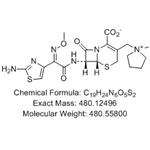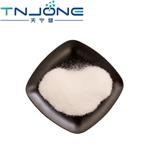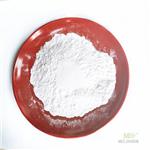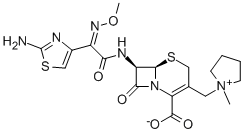- Cefepime
-

- $0.00 / 10mg
-
2024-04-10
- CAS:88040-23-7
- Min. Order: 10mg
- Purity: 90%+
- Supply Ability: 10g
- Cefepime
-

- $0.00 / 1Kg
-
2024-04-09
- CAS:88040-23-7
- Min. Order: 1Kg
- Purity: 99%
- Supply Ability: 10kg
- Cefepime
-

- $0.00 / 25KG
-
2023-08-14
- CAS:88040-23-7
- Min. Order: 1KG
- Purity: 99%
- Supply Ability: 50000KG/month
|
| Product Name: | Cefepime | | Synonyms: | [6R-[(6α,7β(Z)]]-7-[[(2-Amino-4-thiazolyl)(methoxyimino)acetyl]amino]-2-carboxy-8-oxo-5-thia-1-azabicyclo[4.2.0]oct-2-en-3-y1]methy1]-1-methylpyrrolidinium inner salt;(6R)-7α-[[(2-Amino-4-thiazolyl)[(Z)-methoxyimino]acetyl]amino]-3-[(1-methylpyrrolidinio)methyl]-8-oxo-5-thia-1-azabicyclo[4.2.0]oct-2-ene-2-carboxylic acid ion;(6R,6β)-7α-[[(2-Amino-4-thiazolyl)[(Z)-methoxyimino]acetyl]amino]-8-oxo-3-[[(1-methylpyrrolidinium)-1-yl]methyl]-5-thia-1-azabicyclo[4.2.0]octa-2-ene-2-carboxylic acidion;Cefpim;CFPM;(6R,7R)-7-{[(2Z)-2-(2-AMINO-1,3-THIAZOL-4-YL)-2-(METHOXYIMINO)ACETYL]AMINO}-3-[(1-METHYL-1-PYRROLIDINIUMYL)METHYL]-8-OXO-5-THIA-1-AZABICYCLO[4.2.0]OCT-2-ENE-2-CARBOXYLATE;PyrrolidiniuM, 1-[[(6R,7R)-7-[[(2Z)-2-(2-aMino-4-thiazolyl)-2-(MethoxyiMino)acetyl]aMino]-2-carboxy-8-oxo-5-thia-1-azabicyclo[4.2.0]oct-2-en-3-yl]Methyl]-1-Methyl-, inner salt;Cefepime sodium | | CAS: | 88040-23-7 | | MF: | C19H24N6O5S2 | | MW: | 480.56 | | EINECS: | 643-019-5 | | Product Categories: | Pharmaceutical intermediates | | Mol File: | 88040-23-7.mol |  |
| | Cefepime Chemical Properties |
| | Cefepime Usage And Synthesis |
| Brand Name(s) in US | Maxipime
| | Description | Cefepime is a new fourth-generation parenteral cephalosporine antibiotic launched in
1993 in Sweden and France. Cefepime has broad spectrum antimicrobial activity against
Staphylococcus, Strepfococcus, Pseudomonas, and the Enterobacteriaceae, including many
bacterial isolates that are resistant to commonly used ceftazidime and cefotaxime. Its
efficacy has been demonstrated in the treatment of lower respiratory tract infections
especially pneumonia, intra-abdominal and urinary tract infections, skin and soft tissue
infections, chronic osteomyelitis and in prophylaxis of biliary tract and prostate infections. It
is well tolerated by patients and is reported to exhibit no significant drug interactions. | | Chemical Properties | colorless Powder | | Originator | Bristol-Myers Squibb (U.S.A.) | | Uses | Cefepime is used for bacterial infections caused by microorganisms that are sensitive to
drugs in septicemia, bacteriemia, complicated infections of the upper and lower sections
of the urinary system, pneumonia, pulmonary abscesses, emphysema of the pleura, fever
in patients with neutropenia, and infected skin and soft tissue wounds. Synonyms of this
drug are maxipime, cepim, cepimex, and others. | | Definition | ChEBI: Cefepime is a cephalosporin bearing (1-methylpyrrolidinium-1-yl)methyl and (2Z)-2-(2-amino-1,3-thiazol-4-yl)-2-(methoxyimino)acetamido groups at positions 3 and 7, respectively, of the cephem skeleton. It has a role as an antibacterial drug. It is a cephalosporin and an oxime O-ether. It is a conjugate base of a cefepime(1+). | | Manufacturing Process | A mixture of ethyl (Z)-2-hydroxyimino-2-(2-tritylaminothiazol-4-yl) acetate (5
g, 10.9 mmoles), methyliodide (2.04 ml, 32.8 mmoles) and K2CO3 (4.54 g,
32.8 mmoles) in dry DMSO (100 ml) was stirred at room temperature
overnight and then poured into water (250 ml). The precipitate was collected,
washed with water and dried to give 2-methoxyimino-2-(2-tritylaminothiazol-
4-yl) acetate (1.15 g, melting point 115°C (dec.))
Ethyl (Z)-2-hydroxyimino-2-(2-tritylaminothiazol-4-yl) acetate (6 g, 12.7
mmol) in ethanol was treated with 2 N NaOH (12.7 ml) at room temperature
overnight. The mixture was adjusted to pH 8 by the addition of powdered dry
ice and the solvent evaporated. The residue was dissolved in water (100 ml)
and was added to the solution which was acidified with 1 N HCl to pH 2 and
then extracted with ethyl acetate. Extract was evaporated, the residue was
crystallized from ethyl acetate-hexane to afford ethyl (Z)-2-hydroxyimino-2-
(2-tritylaminothiazol-4-yl)acetic acid (5.56 g, melting point 138-143°C (dec.)).
To a suspension of phosphate buffer (pH 7, 162.5 ml) and wheat bran (20 g,
dry) at room temperature was added 7-phenylacetimidocephalosporanic acid
sodium salt (5 g). After 5 hours the suspension was filtered to remove wheat
bran and the filtrate was cooled to 5-10°C, then was added methylene
chloride (32 ml) and 0.5 M solution of diphenyldiazomethane in methylene
chloride (24 ml). The pH was then adjusted to 3.0 with 28% phosphoric acid.
After 1 hour the mixture was allowed to rise to 20°C. Heptane was slowly
added (56 ml) and was recovered benzhydryl 3-hydroxymethyl-7-
phenylacetamido-3-cephem-4-carboxylate (3.0 g, 50%).
The mixture of PCl5(8.3 g) and pyridine (3.2 g) in CH2Cl2 was added to
benzhydryl 3-hydroxymethyl-7-phenylacetamido-3-cephem-4-carboxylate (5.1
g) at -40°C. The mixture was stirred at -10°C for 15 minutes and allowed to
stand at -15-10°C for 7 hours. To the solution at -20°C was added propane-
1,3-diol (10 ml) and the mixture was allowed to stand at -20°C for 16 hours and then at room temperature for 20 minutes. The resulting solution was
washed with ice-water and saturated aqueous NaCl (10 ml), dried and
concentrated. The gummy residue (12 g) was dissolved in CHCl3-hexane
(2:1), and subjected to chromatography using silica gel column and the same
solvent as eluant. After evaporation of the solvents was obtained benzhydryl-
7-amino-3-chloromethyl-3-cephem-4-carboxylate (2.1 g, 51%, melting point
>110°C(dec.)).
Benzhydryl 7-amino-3-chloromethyl-3-cephem-4-carboxylate (2.29 g) was
treated with bis(trimethylsilyl)acetamide (4.06 ml) at room temperature for
50 min to give a clear solution. Top the solution was added an acid chloride
solution, which was prepared from (Z)-2-hydroxyimino-2-(2-
tritylaminothiazol-4-yl)acetic acid (2.04 g) and PCl5 (1.15 g) in methylene
chloride (20 ml). The mixture was stirred at room temperature for 30 min,
poured in cold water (200 ml) and extracted with ethyl acetate (100 ml x 3).
After evaporation of the solution was obtained the syrup (4 g) which was
chromatographed on a silica gel column by eluting with 10:1 and 3:1 mixture
of toluene and ethyl acetate successively. After evaporation of the solvents
was obtained benzhydryl 3-chloromethyl-7-[(Z)-2-methoxyimino-2-(2-
tritylaminothiazol-4-yl)acetamido]-3-cephem-4-carboxylate (2.62 g, 68%).
A mixture of the benzhydryl 3-chloromethyl-7-[(Z)-2-methoxyimino-2-(2-
tritylaminothiazol-4-yl)acetamido]-3-cephem-4-carboxylate (1.50 g, 1.79
mmoles) and NaI (1.34 g, 8.93 mmoles) in methyl ethyl ketone (30 ml) was
stirred at room temperature for 1 hour. After evaporation of the solvent the
residue was dissolved in ethyl acetate (100 ml) and washed with water,
aqueous Na2S2O3 and aqueous NaCl, dried and evaporated to give 7-[(Z)-2-
ethoxyimino-2-(2-tritylaminothiazol-4-yl)acetamido]-3-iodomethyl-3-cephem-
4-carboxilate (1.47 g, 89%) as an amorphous powder.
A mixture of 7-[(Z)-2-ethoxyimino-2-(2-tritylaminothiazol-4-yl)acetamido]-3-
iodomethyl-3-cephem-4-carboxilate (4.5 g, 4.83 mmoles) and N-methylpyrrolidine (0.65 ml, 6.28 mmoles) in CH2Cl2 (45 ml) was stirred at
room temperature for 20 min. Ether (300 ml) was added to the mixture to
separate the quaternary salt of the blocked cephalosporin, which was collected
by filtration and treated with 90% trifluoroacetic acid (TFA) (40 ml) at room
temperature for 1 hour. The mixture was then evaporated under reduced
pressure below 20°C. The residue was triturated with ether to give the TFA
salt of 7-[(Z)-2-methoxyimino-2-(2-aminothiazol-4-yl)acetamido]-3-[(1-
methyl-1-pyrrolidinium)methyl]-3-cephem-4-carboxylate (2.40 g), which was
dissolved in methanol (5 ml) and treated with 1 M solution of sodium-2-
ethylhexoate in ethyl acetate (8 ml) at room temperature for 30 min. After
the addition of ethyl acetate (100 ml), the precipitate (1.94 g) formed was
collected by filtration. HPLC analysis showed that the crude product was 7%
pure with a 1:8 ratio of the δ3 isomer to the δ2 isomer. Purification of the
product by HPLC was repeated three times (Lichrosorb RP-18, eluted with 5%
aqueous methanol or 0.01 M ammonium phosphate buffer (pH 7.2 containing
5% of methanol) to give 35 mg (1.5%) of the title product as a colorless
powder of 7-[(Z)-2-methoxyimino-2-(2-aminothiazol-4-yl)acetamido]-3-[(1-
methyl-1-pyrrolidinium)methyl]-3-cephem-4-carboxylate. Estimated purity (by
HPLC) 90%. M.p. 150°C (dec.). | | Brand name | Maxipime; Axepim | | Therapeutic Function | Antibiotic | | Antimicrobial activity | Its activity against common pathogens is comparable
to that of group 4 cephalosporins, but it is somewhat
more active against Ps. aeruginosa. Like cefpirome it has low
affinity for the molecular class C cephalosporinases of many
Gram-negative rods and is consequently active against
most strains of Citrobacter spp., Enterobacter spp., Serratia spp.
and Ps. aeruginosa that are resistant to cefotaxime and ceftazidime.
It has poor activity against L. monocytogenes and against
anaerobic organisms. | | Pharmacokinetics | Cmax 2 g intravenous (30-min infusion): c. 160 mg/L end infusion
Plasma half-life: c. 2 h
Volume of distribution: 14–20 L
Plasma protein binding: 10–19%
It is well distributed. Penetration into tissues, including lung,
appears to be similar to that of other aminothiazoyl cephalosporins.
Very low concentrations are achieved in CSF in the
absence of meningeal inflammation. It is secreted in breast
milk.
It is partially metabolized, but 85% of the dose is excreted
unchanged in the urine, achieving a concentration approaching
1 g/L within 4 h of a 1 g intravenous dose. Dosage adjustment
is required in patients with impaired renal function,
but hepatic impairment does not affect the pharmacokinetic
properties. | | Clinical Use | Proprietary name: Maxipime.
Preparation: Injection.
Dosage: Adult, i.m., i.v., 1–6 g per day in 2–3 divided doses.
Available in USA, most of Europe and Japan; not available in the UK. | | Clinical Use | Cefepime (Maxipime, Axepin) is a parenteral, β-lactamase–resistant cephalosporin that is chemically and microbiologicallysimilar to cefpirome. It also has a broadantibacterial spectrum, with significant activity against bothGram-positive and Gram-negative bacteria, including streptococci,staphylococci, Pseudomonas spp., and theEnterobacteriaceae. It is active against some bacterial isolatesthat are resistant to ceftazidime. The efficacy of cefepimehas been demonstrated in the treatment of urinary tract infections,lower respiratory tract infections, skin and soft tissueinfections, chronic osteomyelitis, and intra-abdominal andbiliary infections. It is excreted in the urine with a half-life of2.1 hours. It is bound minimally to plasma proteins. Cefepimeis also a fourth-generation cephalosporin. | | Side effects | It is used in the treatment of serious infections, particularly
those in which resistant Gram-negative pathogens are known
or suspected to be involved. | | Synthesis | Cefepime, {6R-[6α,7β(Z)]}-1-[(7-{[(2-amino-4-thiazolyl)-(methoxyimino)
acetyl]-amino}-2-carboxy-8-oxo-5-thia-1-(azabicyclo[4.2.0]oct-2-en-3-yl)methyl-1-
methyl]pyrrolidine chloride (32.1.2.99), is synthesized by a combination of methods
described for the synthesis of third-generation cephalosporins, in particular, cefaloridin
(32.1.2.79) and ceftazidime (32.1.2.82). |
| | Cefepime Preparation Products And Raw materials |
|